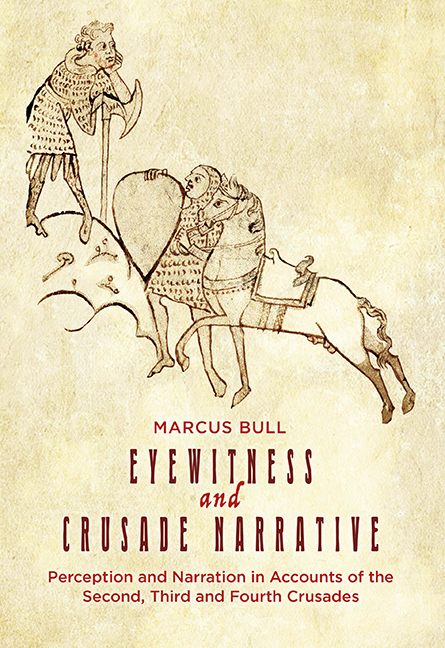 Eyewitness and Crusade Narrative
Eyewitness and Crusade Narrative Book contents
- Frontmatter
- Dedication
- Contents
- Acknowledgements
- Abbreviations
- Introduction: Medieval and Modern Approaches to Eyewitnessing and Narratology as an Analytical Tool
- 1 Memory and Psychological Research into Eyewitnessing
- 2 The Second Crusade: The De Expugnatione Lyxbonensi and Odo of Deuil's De Profectione Ludovici VII in Orientem
- 3 The Third Crusade: Ambroise's Estoire de la Guerre Sainte and Points of Comparison and Contrast
- 4 Geoffrey of Villehardouin's and Robert of Clari's Narratives of the Fourth Crusade
- Conclusion
- Bibliography
- Index
3 - The Third Crusade: Ambroise's Estoire de la Guerre Sainte and Points of Comparison and Contrast
Published online by Cambridge University Press: 12 February 2019
- Frontmatter
- Dedication
- Contents
- Acknowledgements
- Abbreviations
- Introduction: Medieval and Modern Approaches to Eyewitnessing and Narratology as an Analytical Tool
- 1 Memory and Psychological Research into Eyewitnessing
- 2 The Second Crusade: The De Expugnatione Lyxbonensi and Odo of Deuil's De Profectione Ludovici VII in Orientem
- 3 The Third Crusade: Ambroise's Estoire de la Guerre Sainte and Points of Comparison and Contrast
- 4 Geoffrey of Villehardouin's and Robert of Clari's Narratives of the Fourth Crusade
- Conclusion
- Bibliography
- Index
Summary
The history of the Third Crusade known as the Estoire de la Guerre Sainte (c.1195), which is almost certainly to be attributed to an Ambroise who is named no fewer than nine times over the course of the text, commands attention as an eyewitness history for two reasons. It lies at the intersection of important developments in later twelfth-century western historiography; and the text is noteworthy for its supple, multifaceted and creative fashioning of eyewitness authority. As this chapter will argue, eyewitnessing is closely bound up in several of the Estoire's self-authorizing moves. These are, most notably: the construction of the narrator as a close and informed observer; the interplay between individual narratorial perception and attention to collective agency; the co-opting of the reader's or listener's visual imagination in the act of following the narrative; the distribution of focalizing roles, with a particular emphasis on that of King Richard I of England; and, perhaps most importantly, the translation of the immersive experience of participating in the crusade expedition into a number of visually rich diegeses that do not merely punctuate the action in the nature of attention-grabbing vignettes but also programmatically aid the reader's understanding of the story as a whole. In other words, the narrator's ability to speak authoritatively about the course of the crusade is not simply the sum of multiple individual acts of informed and reflective visual perception, significant as these are; it is also a function of his inclusion within numerous collective experiences in which visual sensation is brought to the fore. In this way, and to an even greater degree than the two texts examined in the previous chapter, the Estoire represents an abstracting out of individual eyewitness into a collective experiential register.
Before we examine the Estoire in detail, it is useful to set it in its closely contemporary context. The two narratives of the Second Crusade that we considered above exemplify the challenges posed when one source of necessity dominates our understanding of a given sequence of events. With the Third Crusade (1187–92) we enter a notably fuller evidentiary landscape characterized by a greater number of narratives that were either written by eyewitness participants or were informed, to varying degrees, by eyewitness testimony.
- Type
- Chapter
- Information
- Eyewitness and Crusade NarrativePerception and Narration in Accounts of the Second, Third and Fourth Crusades, pp. 193 - 255Publisher: Boydell & BrewerPrint publication year: 2018


